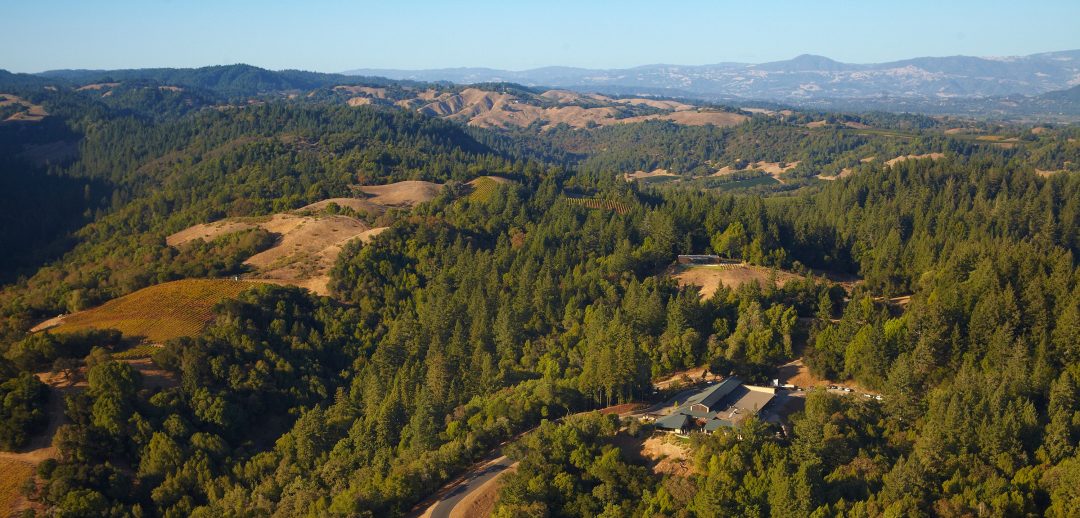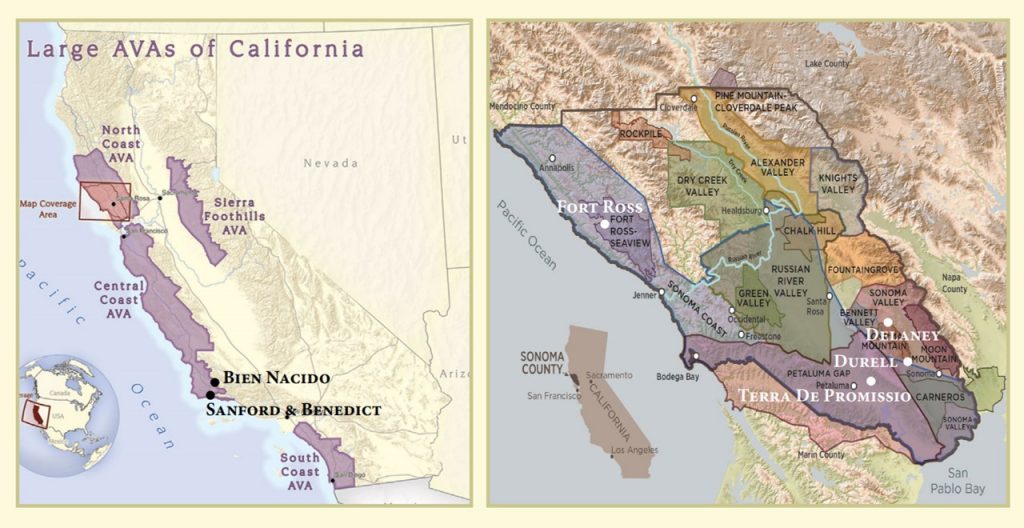Photo credit: Gary Farrell Vineyards (winery, eagle’s nest view)
The wines of Gary Farrell are a testament to the unique and contrasting climate of the Russian River Valley. Plunging your nose in a glass of the 2017 Chardonnay, the ripeness of fruit evokes warmth and abundant sunshine, and yet lipsmacking acidity greets you on the taut, lively palate. The wines are a study in opposites, that most definitely attract.
Gary Farrell launched his eponymous wine label back in 1982. At the time, Napa was starting to gain worldwide attention thanks to the efforts of pioneers like Robert Mondavi, and the media attention garnered from the 1976 Judgement of Paris. However, on the other side of the Mayacamas mountains, Sonoma County remained a discreet and rugged frontierland. That is not to say exciting developments were not afoot. In the Russian River Valley, wineries like Davis Bynum were quietly proving how well suited cool climate varieties like Chardonnay and Pinot Noir were to the region’s cool, Pacific-influenced climate.
Farrell got his start at Davis Bynum, initially as an apprentice and finally as head winemaker. When he bottled his first wine, it was with fruit sourced from renowned local growers like Rochioli, Allen, and Hallberg, using the winery at Davis Bynum. By the late 1990s, the wines of Gary Farrell were widely respected, and production had expanded sufficiently to warrant construction of his own winery. Farrell chose a secluded, area in Healdsburg, the heartland of the Russian River Valley, to build his facility.
Today, the property is owned by an investment group including Bill Price, of reputed Sonoma and Napa Chardonnay specialist, Kistler Vineyards. Farrell may no longer be involved, but his legacy remains. Many of the same grower partnerships, established with a handshake nearly 40 years ago, hold strong. Since 2012, experienced local winemaker, and former chemist, Theresa Heredia has crafted the Gary Farrell wine style. In 2019, the winery attained “Year 2 Status” as a California Certified Sustainable Winemaking (CCSW) winery.
Last week, I had the pleasure of sitting down with Theresa (virtually), to chat Russian River, how she crafts the wines of Gary Farrell, and taste a couple recent releases.
Russian River Valley Overview
Image credit: Gary Farrell Vineyards
The Sonoma County AVA (American Viticultural Area) of Russian River Valley begins on a sharp bend in the Russian River, where it changes its north-south course to head westward toward the Pacific coast. Many liken the region’s shape to a heart, extending south and west over a roughly 25-kilometre span in both directions. Despite decidedly warm, sunny day-time temperatures, the climate is generally deemed cool due to the heavy fogs that permeate the area, slipping through the Petaluma Gap to the south and via a wind tunnel formed by the Russian River, to the west. This phenomenon results in significant diurnal variation, with night time lows up to 20ºC cooler than day time highs.
Just over 6000 hectares are planted here, mainly to Chardonnay and Pinot Noir, as well as some coveted old vine Zinfandel. The region consists of five vineyard areas (or neighbourhoods as they are called locally): Middle Reach, Santa Rosa Plain, Green Valley, Sebastopol Hills, and Laguna Ridge. Each of these neighbourhoods has a distinct mesoclimate, elevation, soil composition, and so forth. The wines of Gary Farrell are made from grapes sourced through longstanding grower partnerships across the valley, producing blends with complimentary elements from various sites, as well as single vineyard cuvées.
Green Valley, the foggiest, coolest neighbourhood of Russian River Valley due to its location closest to the coast, possesses such an individual character that it has been granted separate sub-AVA status within the Valley. It is from the sandy soils of the Hallberg Vineyard located here, that Heredia sources one of Gary Farrell’s most admired Chardonnays.
Gary Farrell Sustainability Commitments
Sonoma County is committed to leading the way in terms of vineyard and winery sustainability. In fact, in 2014 the region set themselves the goal of achieving 100% sustainability for the sector. By 2019, they had achieved 99% of their target. At Gary Farrell, sustainability initiatives include a solar array spanning the length of the winery roof that defrays 93% of the property’s power usage. Their parking lot includes Tesla/EV charging stations to encourage electric car use among staff and visitors. As part of their progression through the CCSW certification process, the winery is developing a continuous improvement plan assessing areas like water conservation, enery efficiency, waste management, social sustainability, and so forth.
The wines of Gary Farrell are made from over three-quarters certified sustainable Chardonnay vineyard sources, and nearly 90% certified sustainable Pinot Noir partners.
Gary Farrell Winemaking & Tasting Notes
Chardonnay Winemaking
Freshness and vibrancy of fruit are key watchwords for Heredia. She prefers to harvest early, when Chardonnay reaches 21 to 23 brix. “My ideal scenario” says Heredia “is Chardonnay with a pH between 3.2 to 3.5 and total acidity of 7 to 9 grams/litre, but obviously this doesn’t always happen!”. After experimenting with varying periods of skin contact, she concluded that she generally prefers the fresh, more delicate quality of rapidly pressed whites. Heredia uses a range of different pressing techniques, each tailored specifically to the Chardonnay source and clone. Fermentation and ageing takes place in lightly toasted barrels on fine lees, using a careful selection of yeasts including Burgundian favourite RC212 and Montrachet.
Gary Farrell Chardonnay “Russian River Selection” 2017
The “Russian River Selection” cuvée is made from a blend of grower partner sites in the Middle Reach, Laguna Ridge, and Santa Rosa Plain neighbourhoods (including Rochioli, Rochioli-Allen, Bacigalupi, Westside Farms, Olivet Lane, and Martinelli). The harvest took place during a total eclipse, at a frenetic pace to beat a forecasted intense heat wave. Ageing lasted nine months, in 35% new French oak.
Initially shy, the nose reveals complex notes of ripe lemon, poached pear, white blossoms, and hints of buttered toast with aeration. The palate is defined by zesty acidity, a taut structure, medium body, and tangy white grapefruit and yellow fruit notes. A subtle layered creaminess comes through on the long, dry, delicately toasted finish. A vibrant, refined Chardonnay with harmonious oaked undertones. Still quite tightly-knit, would benefit from another year or two in cellar for the acidity to soften.
Where to Buy: SAQ ($53.25)
Pinot Noir Winemaking
Heredia has an equally restrained, site-specific approach when it comes to Pinot Noir. She harvests at 22 – 24 brix. Decisions on whether to destem or vinify whole clusters differ depending on the vintage and vineyard, though she likes the “tannin structure, backbone, and spice” that whole cluster fermentation can bring to Pinot Noir. After a three – five day cold soak, must is fermented at cooler temperatures with gentle punch downs, using wild yeasts when possible. Lightly toasted barrels are also employed for Pinot Noir ageing.
Gary Farrell Pinot Noir “Hallberg Vineyard” 2016
Sourced from the Hallberg vineyard site in the cool Green Valley sub-AVA, and aged 15 months in 40% new French oak, this Pinot Noir is fragrant and floral, with vibrant black cherry, exotic spice, and tea leaf aromas. Medium weight on the palate, with brisk acidity, nicely balanced by concentrated flavours of juicy red and black fruits with mocha undertones. Elegant, moderately firm tannins with just a touch of refreshing bitterness that adds interest on the finish. Drinking well now for lovers of more taut, high acid reds, otherwise cellar for three to four years to allow a more supple expression to develop.
Where to Buy: SAQ ($57.00)


